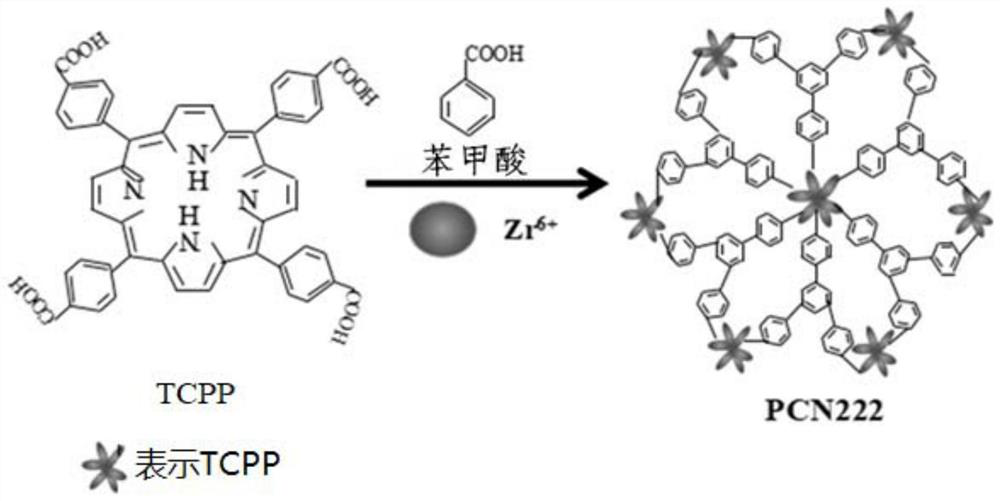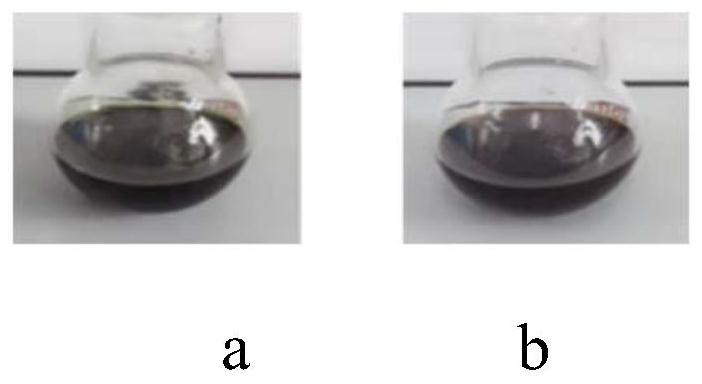Application of nano-enzyme electrode in detecting o-dihydroxybenzene
A catechol and nano-enzyme technology, applied in the field of biosensors, can solve the problems that catechol electrodes have not been reported, and achieve the effects of low cost, high sensitivity and wide selectivity
- Summary
- Abstract
- Description
- Claims
- Application Information
AI Technical Summary
Problems solved by technology
Method used
Image
Examples
Embodiment 1
[0041] Embodiment 1PCN222 synthesis
[0042] Get 50mg of TCPP, 150mg of zirconium oxychloride octahydrate and 2.8g of benzoic acid dissolved in 50mL of DMF containing 1% (volume concentration) deionized water, ultrasonic 10min at 25°C to mix it evenly, then transfer to React in an oil bath at 90° C. for 4 hours, centrifuge at 13,000 rpm / min for 30 minutes after the reaction, and wash with DMF for 3 times to obtain the target product PCN222. The reaction mechanism of embodiment 1 is as figure 1 As shown, the color changes as figure 2 shown, where figure 2 a is the green color of the reaction system before the reaction, figure 2 b: The reaction system is purple in color after the reaction.
Embodiment 2
[0044]Polish the glassy carbon (GC) on the suede with 0.35 μm polished aluminum powder for 6 min, then ultrasonically clean the polished GC 3 times with deionized water and absolute ethanol, and place the GC obtained by ultrasonic cleaning in 1 molL -1 In the sulfuric acid solution, using cyclic voltammetry, the potential is 0-1.7V, with 0.1Vs -1 The scanning speed was scanned 30 times, ultrasonically cleaned and dried to obtain the GC electrode substrate. The PCN222 obtained in Example 1 is ultrasonically dissolved in water to obtain a concentration of 50mgL -1 PCN222 solution, dissolving chitosan in water to obtain a chitosan solution with a mass concentration of 1%, mixing the obtained PCN222 solution with the chitosan solution at a volume ratio of 1:1 to obtain a mixed solution of PCN222 and chitosan, Take 6 μL of the mixed solution of PCN222 and chitosan and drop it on the GC electrode substrate and let it dry naturally at room temperature to obtain the chitosan-PCN222 / G...
Embodiment 3
[0046] The preparation method is basically the same as in Example 2, the only difference is that the concentration of the PCN222 solution is 1gL -1 .
PUM
| Property | Measurement | Unit |
|---|---|---|
| electrical resistance | aaaaa | aaaaa |
Abstract
Description
Claims
Application Information
 Login to View More
Login to View More - R&D
- Intellectual Property
- Life Sciences
- Materials
- Tech Scout
- Unparalleled Data Quality
- Higher Quality Content
- 60% Fewer Hallucinations
Browse by: Latest US Patents, China's latest patents, Technical Efficacy Thesaurus, Application Domain, Technology Topic, Popular Technical Reports.
© 2025 PatSnap. All rights reserved.Legal|Privacy policy|Modern Slavery Act Transparency Statement|Sitemap|About US| Contact US: help@patsnap.com



